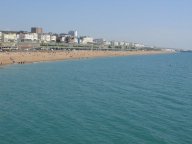
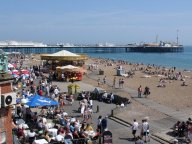
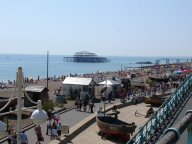



Brighton is a popular seaside town on the south coast of England in the County of Sussex. Strictly speaking, Brighton together with its immediate neighbour Hove forms Brighton & Hove more formerly known as the City of Brighton & Hove, but everyone calls it Brighton.
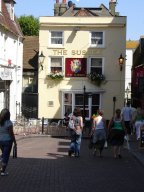 Brighton is recorded in the Domesday Book as Bristelmestune or Bristelmetune, it later became known as Brighthelmston. At the time of the Norman Conquest, Brighton was already a wealthy fishing village. In 1086, Brighton paid an annual rent of 10,000 herrings.
Brighton is recorded in the Domesday Book as Bristelmestune or Bristelmetune, it later became known as Brighthelmston. At the time of the Norman Conquest, Brighton was already a wealthy fishing village. In 1086, Brighton paid an annual rent of 10,000 herrings.
Brighton was originally the tun (village or farmstead) of a Saxon, Beorthelm, the name a derivation of a Saxon chieftain, Bright Helm. Alternative spelling, Bristelmestune.
Brighton rose to prominence with the arrival of day-trippers who came with the arrival of the railway in 1841. Patronage by the Prince Regent meant it was the fashionable place to be seen.
Although the Prince Regent put Brighton on the map as a fashionable place to be seen, its popularity had started to grow in the decades before. It was the advent of sea-bathing for medicinal purposes, that led to Brighton becoming a popular seaside resort.
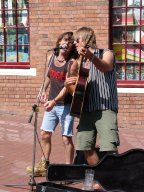 In 1750, Dr Richard Russell of Lewes published A Dissertation Concerning the Use of Sea Water in Diseases of the Glands and by 1754 had opened an establishment for medicinal cures in Hove. Bathing, fully clothed from bathing machines, was in the charge of bathing attendants, called 'dippers' for women and 'bathers' for men.
In 1750, Dr Richard Russell of Lewes published A Dissertation Concerning the Use of Sea Water in Diseases of the Glands and by 1754 had opened an establishment for medicinal cures in Hove. Bathing, fully clothed from bathing machines, was in the charge of bathing attendants, called 'dippers' for women and 'bathers' for men.
Take the wheels off the bathing machines and you have beach huts. Good examples of which can be found along the Hove Promenade.
By 1765, Brighton had become a popular resort for society. Dr Johnson, Fanny Burney and Mrs Thrale were among the early visitors. The Prince Regent, then the 21-year-old Prince of Wales, first visited Brighton in 1783. He liked the place and took up residence.
The Prince Regent took his mistress to Brighton, giving rise to the expression 'a dirty weekend in Brighton'.
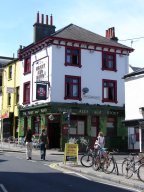 Prior to its rise as a holiday resort, Brighton was a small fishing village. In the 15th century, Brighton could claim 80 fishing boats and 10,000 nets. The Lanes dates from this period.
Prior to its rise as a holiday resort, Brighton was a small fishing village. In the 15th century, Brighton could claim 80 fishing boats and 10,000 nets. The Lanes dates from this period.
Today Brighton is easily accessible by train from London. Change at Gatwick Airport for trains from Guildford and Reading. A line also runs along the coast. The trains from London on a hot sunny Sunday in the summer are standing room only.
Prior to the arrival of the railways, the cost of travel to Brighton from London, for example the cost of a coach ticket from London to Brighton was more than most people could earn in two weeks, was only available to the wealthy, nevertheless, sufficient numbers travelled to Brighton to enable the Theatre Royal to be built in 1807.
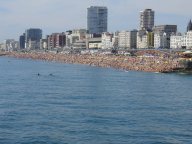 This all changed when the railways opened travel to the masses and made it affordable.
This all changed when the railways opened travel to the masses and made it affordable.
Following the success of the Liverpool & Manchester Railway, a group of businessmen decided to build a railway between London and Brighton. The first train entered Brighton Railway Station on 21 September 1841.
At first, the railway company concentrated on bringing the rich to the coast. It was not long, however, before the company realised that by offering cheap third-class tickets, they could increase the numbers of people using their trains. In 1843, the London to Brighton Railway reduced the price of their third-class tickets to 3s 6d. In the six months that followed this reduction in price, 360,000 people arrived in Brighton by train.
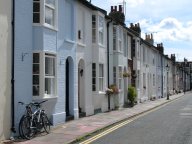 Modern-day Brighton has a fairly good transport system, including railway stations at both Brighton and Hove.
Modern-day Brighton has a fairly good transport system, including railway stations at both Brighton and Hove.
Brighton and Hove, whilst not on a par with London, less still Curitiba in Brazil, has for the UK, a fairly good local transport network, and wandering around the City, there always appears to be plenty of buses about. No doubt ones perception would change whilst waiting in the rain at the bus stop for a long overdue bus. Many of the bus stops have live updates of the buses and it is also possible to monitor the buses via their website.
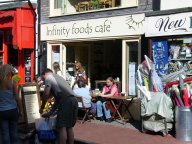 There is a reasonable local cycle network throughout the City, also helped by lack of traffic in the side-streets and areas like North Laine and the Lanes.
There is a reasonable local cycle network throughout the City, also helped by lack of traffic in the side-streets and areas like North Laine and the Lanes.
The local Green Party would no doubt claim the credit having, unusual for the UK, a presence on the local council, Skidrow-on-Sea.
Running down to the seafront from just below Brighton Station, new for the summer of 2006, is a somewhat unusual bus service, a fleet of colourful, motorised rickshaws, each capable of carrying a couple of passengers.
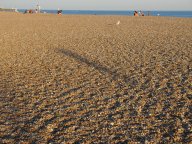 Prominent landmarks in Brighton include the West Pier (1866) and the Palace Pier (1899).
Prominent landmarks in Brighton include the West Pier (1866) and the Palace Pier (1899).
The West Pier was destroyed in an arson attack. Plans to attempt to restore the pier have been abandoned. The West Pier was one of only two Grade I listed piers in England.
The West Pier is embroiled in scandal, and that was even before it was destroyed in an arson attack. Plans to renovate the pier should not be confused with restore to its original Victorian splendour. Supporters of the pier have been badly let down by the West Pier Trust. Equally they have been badly let down by the Regency Square Area Society, a bunch of fuddy-duddys, but nevertheless, an organisation one would have hoped would have been dedicated to retaining Brighton's heritage, but sadly not.
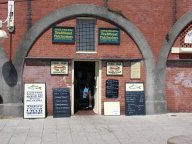 What is left of the pier is to be removed. The team that developed the London Eye, is to erect in its place the Brighton Eye, not as in London a gigantic bicycle wheel, but a tall slender viewing tower.
What is left of the pier is to be removed. The team that developed the London Eye, is to erect in its place the Brighton Eye, not as in London a gigantic bicycle wheel, but a tall slender viewing tower.
Palace Pier, Brighton Pier as it was known and has now reverted to its original name, is in one sense spoilt by the tacky amusements on the pier, on the other hand it is its sheer tackiness of the amusements that gives it its atmosphere.
There used to be a third pier, The Royal Suspension Chain Pier, but this was destroyed in a storm in 1896. At very low tide, the remains of the Chain Pier can be see rising from the sea bed.
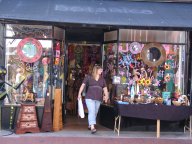 An amazing sight in the evening is to see upwards of a million starlings wheeling around in the night sky. The starlings reside in the derelict West Pier.
An amazing sight in the evening is to see upwards of a million starlings wheeling around in the night sky. The starlings reside in the derelict West Pier.
East of Brighton Pier lies Brighton Marina. A proposed development of a 40-storey tower block on the marina will despoil the view of Kemptown and the seafront.
Inland on the slopes above the marina, lies Kemp Town, an elegant estate laid out for Thomas Reed Kemp during the 1820s. The elegant terraces are comparable with the Nash terraces in Regent's Park in London. The cost of developing the estate bankrupted Kemp and he was forced to flee the country to escape his creditors.
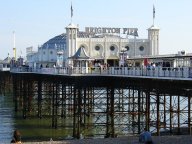 Consisting of pebbles not sand, Brighton lacks a good beach.
Consisting of pebbles not sand, Brighton lacks a good beach.
The Brighton seafront must have one of the highest concentrations of fish n chip shops in the country. Cheap and yucky, rather than quality, is the watchword. The all-pervasive, stomach-churning stench of stale cooking oil is disgusting.
The offerings on the sea food stalls are better, if not somewhat pricey.
Look out for a traditional seafood shop tucked into the Arches, between the two piers.
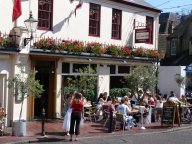 Also tucked in beneath the Arches is the Brighton Fishing Museum and a Penny Arcade. There used to be two penny arcades, but one has closed down.
Also tucked in beneath the Arches is the Brighton Fishing Museum and a Penny Arcade. There used to be two penny arcades, but one has closed down.
Volk's Electric Railway, constructed in 1883, runs along the seafront from the Palace Pier to Black Rock. It is claimed to be the world's oldest operating electric railway.
On Saturday nights, Brighton is very lively with drunks wandering from pub to club. There is a strong police precence on the streets at night.
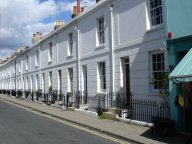 Just up from the seafront, the Lanes is an area of narrow winding streets and alleyways with a Continental café culture where during the daytime in the summer it is possible to sit and eat and drink outside. The Lanes was the core of the old fishing village before Brighton took off as a fashionable seaside resort.
Just up from the seafront, the Lanes is an area of narrow winding streets and alleyways with a Continental café culture where during the daytime in the summer it is possible to sit and eat and drink outside. The Lanes was the core of the old fishing village before Brighton took off as a fashionable seaside resort.
The area now known as the Lanes was razed to the ground by the French in 1514. The street pattern of today reflects the medieval street pattern.
Some of the oldest pubs in Brighton are to be found in the Lanes. One of the oldest is The Druid, dating from 1510.
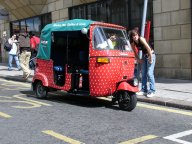 The Druids Head, or The Druid, dates from 1510. It takes its name from a ring of stones excavated nearby two centuries ago. The stones were believed to be connected to the druids. The original building dates from 1510. It was licensed as a beer house in 1830. It faces what used to be the original town square of Brighthelmstone, the original fishing village. During the 18th century the tavern was associated with silk and liquor smuggling and a tunnel used to run from its cellars down to the beach. A second tunnel ran to the Royal Pavilion.
The Druids Head, or The Druid, dates from 1510. It takes its name from a ring of stones excavated nearby two centuries ago. The stones were believed to be connected to the druids. The original building dates from 1510. It was licensed as a beer house in 1830. It faces what used to be the original town square of Brighthelmstone, the original fishing village. During the 18th century the tavern was associated with silk and liquor smuggling and a tunnel used to run from its cellars down to the beach. A second tunnel ran to the Royal Pavilion.
Established in 1864, The Bath Arms claims to be the oldest pub in the Lanes, having previously been two cottages, one a fruit shop and the other owned by John Burridge, a hat and cap maker. The Bath Arms was originally known as The True Briton Eating and Beer House, changing its name to the the Bath Arms in 1868. In the cellar is a bricked-up old tunnel which connects with the maze of underground passages running beneath the Lanes. The pub sign depicts a man in a bath tub.
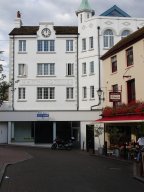 To the north of the Lanes, across North Street, lies the North Laine area which is often confused with the Lanes but in fact derives its name from the Anglo-Saxon word Laine, a local name for a strip of agricultural land. Other streets and areas take their name from their respective Laine, such as Atlingworth Street in Kemptown, within the ancient Atlingworth Laine. The North Laine is regarded as more bohemian than the Lanes, with a mix of cafés, book shops, second-hand clothes shops, record shops, New Age, earthy coffee shops, food shops, avant-garde shops and several theatres. Alternative lifestyle writ large.
To the north of the Lanes, across North Street, lies the North Laine area which is often confused with the Lanes but in fact derives its name from the Anglo-Saxon word Laine, a local name for a strip of agricultural land. Other streets and areas take their name from their respective Laine, such as Atlingworth Street in Kemptown, within the ancient Atlingworth Laine. The North Laine is regarded as more bohemian than the Lanes, with a mix of cafés, book shops, second-hand clothes shops, record shops, New Age, earthy coffee shops, food shops, avant-garde shops and several theatres. Alternative lifestyle writ large.
North Laine is no clone town. Instead a wide range of quirky, independent shops and restaurants. Quality places to eat like Iydea and Infinity Foods Café; Resident, an independent record shop; Brighton Books, a secondhand bookshop; and Infinity Foods, a rarity these days where food shopping is actually a pleasure.
Anita Roddick (1942-2007) opened the very first Body Shop in North Laine. Sadly not long before her death the Body Shop chain was sold to a multinational company whose business ethics were the antithesis of the Body Shop.
There are a number of good, though pricey secondhand bookshops in North Laine. I was pleased to be able to pick up several books by the Brazilian author Paulo Coelho. Especially pleased as I had until then not found his books elsewhere. [see Synchronicity and Paulo Coelho]
There is also a good bookstall to be found on the seafront on Sundays near the derelict West Pier.
The vitality and character of any town depends on the diversity of shops as found in North Laine. Too many towns are Clone Town, identikit High Street names making every town look the same. Too many towns have been destroyed by greedy property developers with the help of the councillors and planners they have in their pockets.
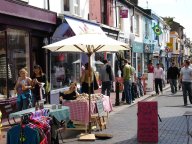 In North Laine one is spoilt for choice for places to eat, although you will be hard pushed to find anywhere to eat on a Sunday night. Two of the best places to eat are Iydea and Infinity Foods Café (a little pricey, connected to Infinity Foods, sponsors of Seedy Sunday).
In North Laine one is spoilt for choice for places to eat, although you will be hard pushed to find anywhere to eat on a Sunday night. Two of the best places to eat are Iydea and Infinity Foods Café (a little pricey, connected to Infinity Foods, sponsors of Seedy Sunday).
Iydea was established summer of 2006, one year on in the summer of 2007, Iydea had already firmly established its reputation as the place to eat in North Laine, if not one of the places to eat in Brighton. Apart from being a place to enjoy good food and in the summer sit outside, relax and watch the world go by, Iydea is also a BookCrossing zone.
Iydea is one, Brighton Pier is another, of a number of BookCrossing zones that have been established in and around Brighton. BookCrossing zones are locations where books are released into the wild, their progress tracked through the Internet via a unique BookCrossing ID (BCID).
What used to be one of the best places to eat was not to be found in North Laine. Copacabana, an excellent little Brazilian restaurant with good food and a pleasant atmosphere, a little way down from the station on the right on the main road leading down from the station to the seafront. Sadly Copacabana is no more, it closed in 2007.
Another good eating place is Bom-Bane's, just up from Brighton Pier on the edge of Kemptown. Their food is excellent, a very pleasant atmosphere downstairs, some very interesting and quirky tables, and often live music. Wherever possible, their ingredients are seasonal and locally sourced, their fish freshly caught locally.
Jane Bom-Bane and Nick Pynn do not just produce good food at Bom-Bane's, they are are also musicians of some note, hence the live music nights at the restaurant. Their albums are on sale at Bom-Bane's.
If you like fish, try Jack and Linda Mills, traditional fish smokers down on the seafront near the Fisherman's Museum. Their fresh crab sandwiches are excellent. Nearby is a stall selling freshly caught fish, if you want some quality fish to take home. The traditional Smoke House is used almost daily to smoke fish.
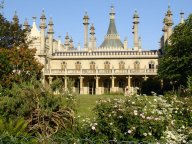 In the same general area as the Lanes and North Laine can be found the Royal Pavilion (also known as the Brighton Pavilion), a former Royal palace designed by John Nash, home of the Prince Regent during the early 1800s. You either love it or hate it, exotic extravaganza, Oriental-Gothic, the height of bad taste, Indian architecture with an Oriental interior. In the summer every square each of the grass in the shade is covered with bodies. Also within the palace grounds lies the Brighton Dome.
In the same general area as the Lanes and North Laine can be found the Royal Pavilion (also known as the Brighton Pavilion), a former Royal palace designed by John Nash, home of the Prince Regent during the early 1800s. You either love it or hate it, exotic extravaganza, Oriental-Gothic, the height of bad taste, Indian architecture with an Oriental interior. In the summer every square each of the grass in the shade is covered with bodies. Also within the palace grounds lies the Brighton Dome.
During World War II, Brighton was heavily bombed. The Pavilion was left intact as Adolf Hitler wished to use it as his headquarters following the German invasion.
Queen Victoria ordered that trains stop outside Brighton whilst she was in residence at the Pavilion. With trains too often stopping short of Brighton on a Sunday one is left wondering whether or not her order was ever rescinded. Maybe someone should tell Network Rail.
Just outside the palace grounds, and now lying derelict, even though restored in 1994, is a large Victorian fountain.
To the west of the West Pier, and lying in a semi-derelict state, is a lovely old Victorian bandstand. Designed by Phillip Lockwood in 1883, the Western Bandstand is a Grade II Listed Building. If Skidrow-on-Sea gets its act together, there are plans to restore the bandstand and its grounds to its former Victorian splendor.
Restoration of the Western Bandstand is part of an ongoing programme started in 1994 of environmental improvements and regeneration of the promenade and seafront. The restoration was awarded the Civic Trust Award for Landscape Design in 2001:
This is an ambitious and impressive scheme that has been extremely successful. The design is bold and full of character and surprise, yet subtle in its detailing and use of materials. All in all, it seems totally appropriate for a city that is unique in its flamboyance and cultural richness.
The restoration has been tastefully carried out, it is nice to know Skidrow-on-Sea can get something right.
Walking westward along the seafront, from Brighton Pier, there is stunning architecture lining the seafront, with the exception of the ugly Brighton Centre, for which Brighton should hang its head in shame.
Beyond the Western Bandstand, the broad Hove Promenade and Hove. Although the promenade is broad, there are signs threatening dire consequences to anyone who dares cycle along the promenade. Similar signs are to be found in the parks and open spaces to anyone who dares consume alcoholic beverages out in the open.
Prominent landmarks are the shelters that line the promenade, Brunswick Terrace and the Old Market.
Although now part of Brighton and a contiguous development with Brighton, Hove is a separate development to Brighton and considers itself to be a cut above Brighton. The atmosphere in Hove is completely different to Brighton, if Brighton is loud and brash, Hove is more genteel and above the common pursuit of making money.
Brunswick Terrace and Brunswick Square, is an elegant development of the early 19th century.
The Old Market is an old market hall. It is now home to the Hanover Band, used to stage concerts and talks, and hosts the annual Seedy Sunday Brighton.
The Brighton and Hove Engineerium is located in Hove, adjacent to Hove Park. It is a museum housing a collection of machines, tools and engines, including the Goldstone Beam Engine built in 1876. Other exhibits include railway engines, fire engines and cooking machines. The Engineerium holds special steam days.
The boundary between Hove and Brighton is marked by the King Edward Memorial, a winged figure of Peace cast in bronze on a pedestal of Portland stone.
Overlooking the sea and just below the Lanes to the west of the Brighton Pier, is the Old Ship Hotel. Claimed to be the oldest inn in Brighton, it dates from the 16th century, having been rebuilt in the 19th. Famous visitors include Charles Dickens and William Makepeace Thackeray.
Dickens wrote part of Barnaby Rudge in the Old Ship Hotel, Thackeray wrote some of the early chapters of Vanity Fair whilst he stayed there.
Dickens was a frequent visitor to Brighton, and mentions Brighton in Dombey and Son. The 'castle' of the 'ogress and child-queller' the austere Mrs Pipchin, was in a 'steep by-street', whilst the superior and 'very expensive' establishment of Dr Blimber fronted the sea.
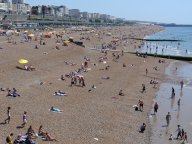 Thackeray, who coined the expression 'Kind, cheerful, merry Doctor Brighton', also mentions Brighton in The Newcomes.
Thackeray, who coined the expression 'Kind, cheerful, merry Doctor Brighton', also mentions Brighton in The Newcomes.
Another literary connection is that of Graham Greene. Not one of his better novels, Graham Greene based Brighton Rock in Brighton.
Other writers who mention Brighton in their writings include: Macaulay who described the old fishing village, ie the area now known as the Lanes, in his History of England, Jane Austen Pride and Prejudice and Mansfield Park, Frances Burney Evelina, G K Chesterton Orthodoxy, Daniel Defoe A Tour Through the Whole Island of Great Britain, Sir Arthur Conan Doyle (best known for Sherlock Holmes) Rodney Stone, George Gissing New Grub Street and Henry James The Golden Bowl.
The film of Brighton Rock, set in the inter-war years, screenplay by Grahame Greene and Terence Rattigan, features a chilling performance by Richard Attenborough as the baby-faced psychopathic killer Pinkie Brown. The film is also an excellent period piece of Brighton.
Brighton Rock was selected for The Big Read in 2003. [see The Big Read: Brighton Rock]
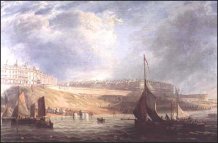 Artistic visitors to Brighton include John Constable and the Victorian painter James Wilson Carmichael. Both painted pictures of the Brighton sea front.
Artistic visitors to Brighton include John Constable and the Victorian painter James Wilson Carmichael. Both painted pictures of the Brighton sea front.
Born the son of a shipwright, James Wilson Carmichael (1800-1868), was born in Newcastle-upon-Tyne. In 1840, Carmichael moved to Brighton where he painted several paintings including: Kemptown from the Sea (1840), The Seafront at Brighton (1847), The Brighton Viaduct (1848) and The Brighton Viaduct on the Brighton, Lewes and Hastings Railway (1848). The last two paintings were exhibited at the Royal Academy in 1848. He died in Scarborough in 1868.
The artist Aubrey Beardsley lived in Brighton.
The Brighton Book, published by local publisher Myriad Editions to coincide with the Brighton Festival, has specially commissioned pieces by local artists, writers and poets.
Brighton-based Myriad Editions are publishes of geo-political atlases, such as The State of the World Atlas, and Funny Weather, the highly acclaimed guide to global warming and climate change by Kate Evans.
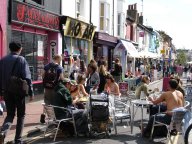 Notable music output from Brighton are the Hanover Band and The Levellers. As different as chalk and cheese. Hove-based Hanover Band are an early music group playing on traditional instruments. The Levellers are a folk-rock group, ignored by the mainstream, with strong green-anarchist credentials. The Levellers have ploughed money back into the music scene in Brighton, making their recording studio available to other bands, and for many years have helped support the Brighton-based radical newssheet SchNEWS.
Notable music output from Brighton are the Hanover Band and The Levellers. As different as chalk and cheese. Hove-based Hanover Band are an early music group playing on traditional instruments. The Levellers are a folk-rock group, ignored by the mainstream, with strong green-anarchist credentials. The Levellers have ploughed money back into the music scene in Brighton, making their recording studio available to other bands, and for many years have helped support the Brighton-based radical newssheet SchNEWS.
Brighton has a thriving street music scene. One to avoid is the fat lady singing outside the Sussex in the Lanes, she is bloody awful. One of the most interesting, if not intriguing, is Paul Harrison on his XPiano, an instrument built of recycled and reclaimed piano parts, tuned to unusual scales.
If you are very lucky you may find singer-guitarist Carly Bryant. If you do, pick up a copy of her album Twelve. You will not regret it, it is brilliant!
Then there are Jane Bom-Bane and Nick Pynn, who not only play music, but also manage to produce excellent food at Bom-Bane's, a restaurant in George Street on the edge of Kemptown, just up from Brighton Pier. Their albums are on sale at Bom-Bane's.
Undisciplined Art is an album of haunting music by local band Jacob's Stories. The album is a limited edition of 500. Each album has a unique piece of art included. One track, 'Hell, Brighton, Home', is specifically about Brighton.
Oh little seaside town
I like you just the way that you are
Liam and Dylan are two very talented young musicians who I came across one afternoon performing on the street their own music and the Bob Dylan classic 'Knocking on Heaven's Door'.
Mechanical Bride, an alternative folk-rock group, have produced the excellent Part II EPs.
French radio station FIP FM (91.0 MHz and 98.5 MHz and Astra 19.2 E), broadcasting an eclectic mix of music with minimum DJ banter and no advertising, has achieved something of a cult status in Brighton where it has had an influence on the local music scene.
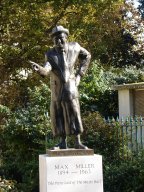 Max Miller (1894-1963), a popular music hall star in the 1930s, 40s and 50s, was born in Brighton. He will be best remembered for his loud suits and catch phrase 'Now there's a funny thing'. A statue to Max Miller can be found outside the Palace Theatre by the entrance to the Royal Pavilion Gardens. The statue was originally unveiled by Roy Hudd, George Melly, June Whitfield and Norman Wisdom on behalf of the Max Miller Appreciation Society. Roy Hudd, president of the Max Miller Appreciation Society, played Max Miller in a Dr Who audio production Pier Pressure. The Society publishes a quarterly magazine There'll Never be Another. The location of the statue attracted a degree of controversy, resulting in it being unveiled twice! The statue of Max Miller is pointing to the site of the now non-existent Oxford Music Hall, a former music hall where Max Miller often performed. [see Row over Max Miller statue]
Max Miller (1894-1963), a popular music hall star in the 1930s, 40s and 50s, was born in Brighton. He will be best remembered for his loud suits and catch phrase 'Now there's a funny thing'. A statue to Max Miller can be found outside the Palace Theatre by the entrance to the Royal Pavilion Gardens. The statue was originally unveiled by Roy Hudd, George Melly, June Whitfield and Norman Wisdom on behalf of the Max Miller Appreciation Society. Roy Hudd, president of the Max Miller Appreciation Society, played Max Miller in a Dr Who audio production Pier Pressure. The Society publishes a quarterly magazine There'll Never be Another. The location of the statue attracted a degree of controversy, resulting in it being unveiled twice! The statue of Max Miller is pointing to the site of the now non-existent Oxford Music Hall, a former music hall where Max Miller often performed. [see Row over Max Miller statue]
Brighton parades itself as the gay capital of England. A Gay Pride Festival takes place in the middle of summer, usually end of July, early August, and includes the Brighton Parade.
Seedy Sunday Brighton takes place in Brighton during February. Seedy Sunday Brighton is a community seed swap, a must for gardeners to obtain hard to get vegetable varieties, and it helps preserve genetic diversity. [see Seeds of Dissent and Seed saving]
During May, Brighton hosts the three-week Brighton Festival. Running concurrently with the Brighton Festival is the Brighton Festival Fringe.
The biennial Brighton Early Music Festival is a month long festival running from the end of September through to end of October. From humble beginnings in 2002, it entered its fourth year in 2006 as one of the largest early music festivals in the country. The theme for 2006, cultural migration. For 2006, Brighton is to host the Early Music Network, with a weekend of events all over Brighton and Hove during the last weekend of September. Emma Kirby is the festival president.
New for 2006, Brighton Live premiered the North Laine Mini-Festival on Saturday 30 September 2006. An evening of music hosted across North Laine in various cafés, bars and record shops.
Car Free Day has become an annual event in Brighton. Several streets are closed to traffic and a celebration of the cycle takes place with various activities throughout the day.
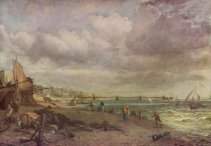 Brighton Critical Mass is held on the last Friday of every month.
Brighton Critical Mass is held on the last Friday of every month.
Brighton is home to SchNEWS, the must read radical almost weekly newssheet and the monthly Rough Music.
Brighton is regularly lampooned in the satirical magazine Private Eye as Skidrow-on-Sea, for the piss-poor performance of its local administration.
One of the more recent scandals to hit Skidrow-on-Sea are plans to build a tower block on the Brighton Marina which will exceed the height limit, break an Act of Parliament, and despoil views of the seafront and the elegant terraces of Kemp Town. The local Member of Parliament Des Turner MP, at the behest of the developer, e-mailed the councillors urging them to push through the 40-storey block on behalf of the developer. The councillors duly pushed the proposal through on the nod, as is the wont of such councils. [see Skidrow-on-Sea approves tower block on Brighton Marina]
Arms manufacturer EDO is based in Brighton. Regular demos take place to try to shut EDO down. Attempts by EDO to serve injunctions on the protesters badly backfired on EDO and they were forced to pay compensation to the protesters, money which is now used to help finance the EDO protests. Poetic justice indeed! Meanwhile, EDO shares have gone into free fall and EDO were recently named as Forbes worst performing company.
SchMOVIES, from Brighton-based SchNEWS, has film footage of the colourful Smash EDO demonstrations. [see DVD Collection 2005]
Brighton together with Hove is a transition town. It will draw up a plan to move towards localisation, reduce its energy consumption. All worthy aims, and a step in the right direction, but the reluctance to challenge existing power structures and the keenness to work within the system may mean it is too little too late. [see Lost in Transition and Transition towns]
Founded in 1880, and originally called the Evening Argus, the local paper for Brighton is The Argus.
A popular excursion from Brighton is to Devil's Dyke on the South Downs, a deep combe cut into the Downs. Legend has it that the Devil not happy with the large number of churches in Sussex was cutting a dyke to the sea. Disturbed by the noise, a pious old lady came out with her lamp to investigate. Thinking that dawn was approaching and he'd be discovered, the Devil fled, leaving his work half complete.